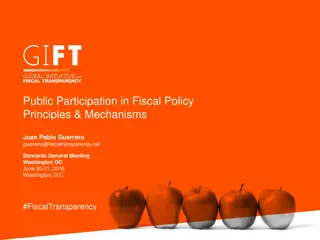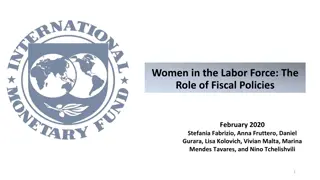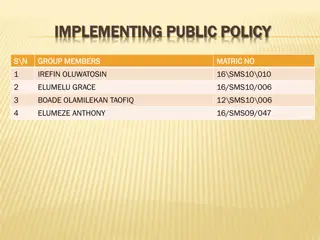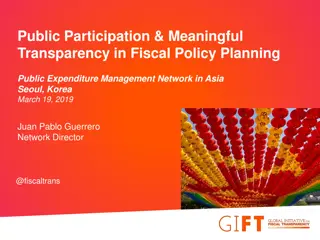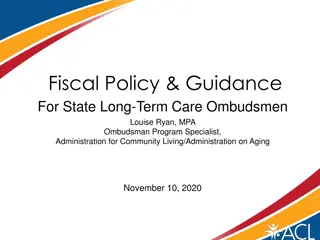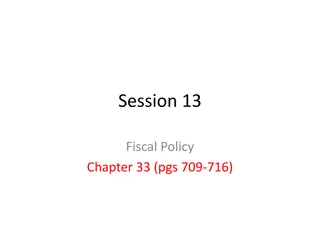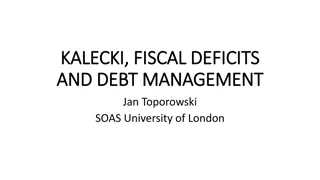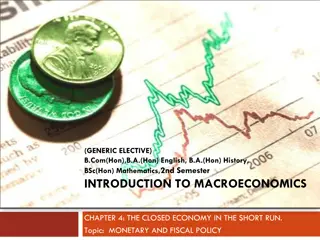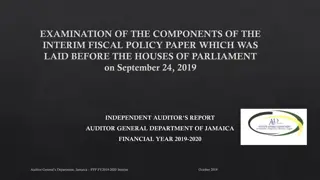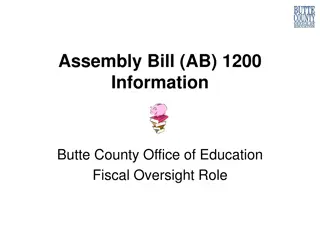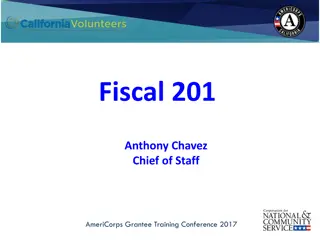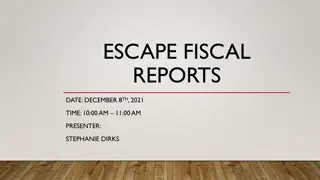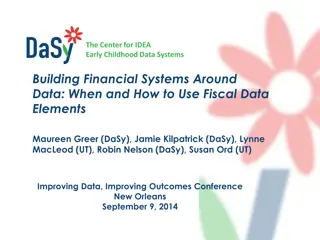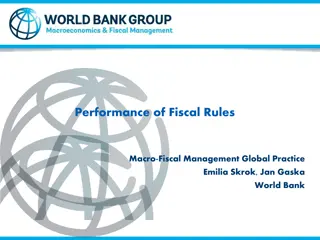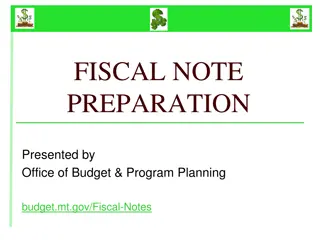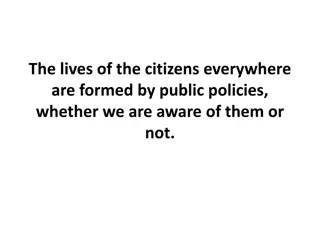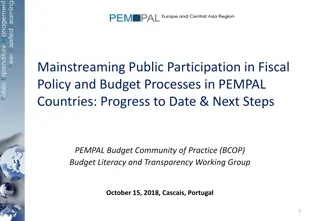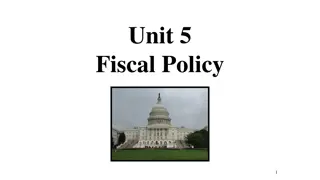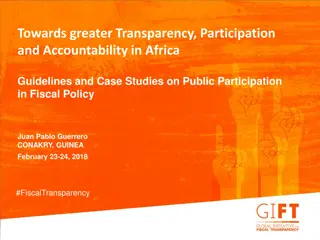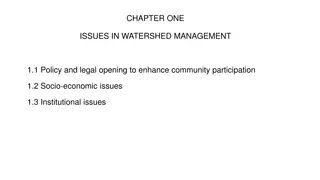Enhancing Public Participation in Fiscal Policy Design and Implementation
Public participation in fiscal policy processes is essential for improving resource allocation, targeting policies to meet citizens' needs, empowering citizens, broadening dialogue, reducing corruption, enhancing service delivery, reforming state agencies, and increasing government legitimacy. This participation involves citizens, civil society organizations, businesses, and non-state actors interacting with public authorities on taxation, revenue collection, spending, and asset management. The importance of public participation is highlighted through case studies and global surveys on open budget initiatives.
Download Presentation

Please find below an Image/Link to download the presentation.
The content on the website is provided AS IS for your information and personal use only. It may not be sold, licensed, or shared on other websites without obtaining consent from the author. Download presentation by click this link. If you encounter any issues during the download, it is possible that the publisher has removed the file from their server.
E N D
Presentation Transcript
Citizens and non-state actors should have the right and effective opportunities to participate directly in public debate and discussion over the design and implementation of fiscal policies. GIFT High Level Principle 10, Endorsed by the United Nations General Assembly, December 2012 Brian Wampler December 1, 2015
GIFTs Definition: Public Participation 2 Public participation in government fiscal policy and budget processes refers to the variety of ways in which citizens, civil society organizations, businesses and other non- state actors interact directly with public authorities on issues relating to government taxation and revenue collection, resource allocation, spending and the management of public assets and liabilities.
Why Public Participation 3 Governments, citizens, civil society organizations and non-state actors use public participation to: Improve the allocation of scarce public resources Better target public policies to meet citizens needs empower citizens Broaden public dialogue Reduce corruption Improve service delivery Reform state agencies Increase government legitimacy
Talk Outline 4 Case Selection: 8 cases Window of Opportunity for reform Constitutional reform, new regime Change of party system Variation in policy type Centralized vs. multi-tiered integration Broad inclusion vs. policy experts/NGOs Formulation, approval implementation, oversight What explains variation Party system Roots of reform local-led vs. national led International actors Identifiable Impacts Institutional redesign
Case Selection: Regional leaders 5 First wave: Philippines, South Korea, Brazil Second wave: Canada, Croatia, Kenya, Mexico, South Africa
Open Budget Survey 6 2015 World Ranking 2015 Regional Ranking 2012 World Ranking 2012 Regional Ranking 2015 2006 2008 2010 2012 77 6 1 Brazil 74 74 71 73 12 1 53 36 7 Croatia 42 59 57 61 22 6 48 46 6 Kenya 48 58 49 49 46 7 66 17 3 Mexico 50 55 52 61 23 3 Philippi nes 64 23 3 51 48 55 48 48 6 South Africa 86 3 1 83 75 85 73 5 1 South Korea 65 19 3 73 66 71 75 9 2
Open Budget Survey Participation/Oversight Scores 7 Participation/Ov ersight 2015 75 Participation/ove rsight 2012 56 Participation 2015 71 Oversight 2015 79 Brazil 54 38 45 41 Croatia 56 33 53 43 Kenya 46 44 58 51 Mexico 60 67 51 59 Philippines 85 65 89 76 South Africa 75 83 67 75 South Korea
Windows of Opportunity 8 Regime Change Constitutional change Shift in party system Growth of civil society
Institutional Variation 9 Centralized vs. multi-tiered integration Broad inclusion vs. policy experts/NGOs Formulation, approval implementation, oversight
Multi-tiered integration vs. Centralized 10 Multi-tiered integration Vertical links between national and subnational units Great ties among national-level institutions Centralized in national-level Led by one or two ministries Focus on participation in national-level policies
Who participates? 11 Ordinary citizens NGOs, professional CSOs CBOs Policy Experts
Policy Moment 12 Formulation Increased use with smaller distance between citizens and government officials w/ budgetary authority Greater resources present Approval Stronger legislature; multi-party system; counter to bureaucracy Implementation Oversight Local Involve citizens to monitor far-flung agents National Involve CSOs and policy experts to monitor complex state operations
Institutional Design Variation 13 National-focus or Multi-tiered Key participants Key innovations: Policy Stage Medium-term Planning Brazil Multi-tiered Citizens/CBOs Formulation Yes Canada National Citizens Formulation No Croatia National CBOs No Korea National Policy experts Approval Yes Kenya Multi-tiered CBO/CSOs Formulation Yes Mexico National NGOs/policy experts Oversight No Philippines Multi-tiered Citizens/CBOs Oversight No South Africa National Citizens/CBOs Oversight No
Explaining adoption 14 Local to national vs. National-led Renewal type Regime change + New Constitution Party system expansion Configuration of civil society Party system From one-party to multi-party # of parties International actors World Bank Open Government Partnership
Identifiable impacts to date 15 Institutional adoption and adaptation Considerable experimentation across 8 countries Changes in spending patterns South Korea Changes in policy directives Brazil Changes in Service delivery Philippines South Africa
Where to from here? 16 Making better use of OBS--- Cross-national comparison Better link results from Transparency to Participation scores Meta-Study of National-level Fiscal Participatory Institutions (Like Mansuri and Rao 2014) Identify links between participatory institutions and changes/shifts in policies adoption And, eventually, impact on participation on outcomes
Concluding remarks 17 Extensive policy adoption and adaptation Multi-tiered integration Wide range of actors across policy venues Different moments of policy cycle However Limited evidence to demonstrate impact of institutions



